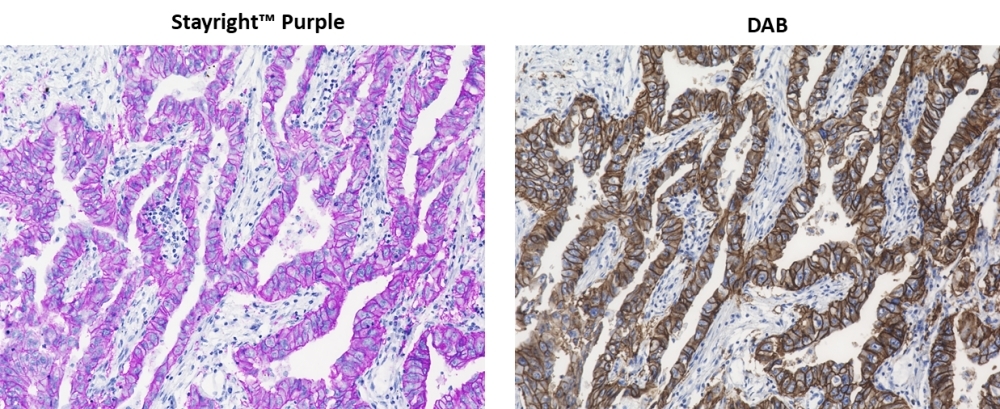ReadiUse™ Stayright™ Purple
HRP Chromogen Premixed with Hydrogen Peroxide
3,3'-Diaminobenzidine (DAB) has been used as the most commonly used IHC chromogen because it is inexpensive and sensitive for routine applications. However, DAB has been shown to be mutagenic and hazardous to laboratory workers and the environment. In order to address this issue, AAT Bioquest has developed this novel Stayright™ Purple as a significantly safer IHC chromogen than DAB. Furthermore, Stayright™ Purple provides a rapid and simple method to develop clean and intense purple stain in the presence of HRP with high sensitivity as DAB. The ready-to-use Stayright™ Purple HRP substrate also shows non-mutagenic effects with minimal cytotoxicity. ReadiUse™ Stayright™ Purple Peroxidase (HRP) Substrate is suitable for use in peroxidase (HRP)-based immunohistochemistry (IHC) and in situ hybridization (ISH) staining methods. The substrate is a stable pre-mixed solution containing hydrogen peroxide so all mixing steps are eliminated and is ready to use. Upon HRP-induced oxidation, Stayright™ Purple forms a purple insoluble precipitating product at the target site of your assay. The purple end product is insoluble in organic solvents and organic mounting media, thus the distinct purple stain can maintain through regular dehydration and coverslipping steps.


| Catalog | Size | Price | Quantity |
|---|---|---|---|
| 45900 | 5 mL | Price | |
| 45901 | 50 mL | Price |
Storage, safety and handling
| H-phrase | H303, H313, H333 |
| Hazard symbol | XN |
| Intended use | Research Use Only (RUO) |
| R-phrase | R20, R21, R22 |
| Storage | Refrigerated (2-8 °C); Minimize light exposure |
| UNSPSC | 12352200 |
Instrument settings
| Light microscope | |
| Instrument specification(s) | White light |
Documents
Contact us
| Telephone | |
| Fax | |
| sales@aatbio.com | |
| International | See distributors |
| Bulk request | Inquire |
| Custom size | Inquire |
| Technical Support | Contact us |
| Request quotation | Request |
| Purchase order | Send to sales@aatbio.com |
| Shipping | Standard overnight for United States, inquire for international |
Page updated on December 15, 2025
